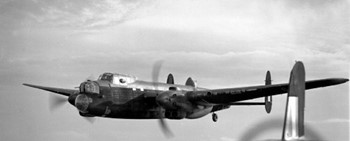Research
Research
Research
The Aircraft of Bomber Command – the Avro Manchester
The Avro Manchester had a relatively short service life with Bomber Command suffering from several operational challenges. It is remembered, however, as the predecessor of the Avro Lancaster. In laying the groundwork for its later sibling, the Manchester’s is a story of ambition, technical challenges, and eventual triumph through iterative design.

Manchester Mark I of No. 207 Squadron RAF, Waddington
(Credit: NZBCA Archives)
The Manchester was conceived in response to a 1936 Air Ministry specification that called for a twin-engine heavy bomber capable of long-range operations.
Avro’s design, led by Chief Designer Roy Chadwick, sought to meet these ambitious requirements using the new Rolls-Royce Vulture engines. The Vulture, a 24-cylinder X-type engine, promised high power and efficiency, making it an attractive choice for the Manchester.
The aircraft featured a monoplane design with a sleek fuselage, twin tail fins, and a capacious bomb bay capable of carrying up to 10,350 pounds of ordnance. Its defensive armament included power-operated gun turrets in the nose, tail, and mid-upper positions.
On paper, the Manchester appeared to be a formidable addition to the Royal Air Force’s bomber fleet. It entered service in November 1940, initially deployed with Bomber Command squadrons for night bombing operations.
Operational experience quickly revealed significant issues, primarily stemming from its underperforming and unreliable Vulture engines. Specifically, the power output from the new engine was significantly less than was intended. The aircraft was seriously underpowered for one that was required to carry a heavy bomb load over long distances. Many Manchester aircrews would describe how flying the aircraft on two engines was difficult enough and if you lost one during operations, you would not likely be coming home.
The Vulture engines also developed a tendency to destroy themselves, whilst running up prior to take off, the result of engine bearings of inferior quality. While a bearing collapse before take-off would result in an unserviceable aircraft and a lengthy period in the maintenance hangar, if it happened in the air, it could be catastrophic.
Furthermore, the Manchester’s handling characteristics were also challenging for pilots, particularly in adverse weather. Its twin-tail design, while innovative, contributed to stability issues that further complicated its performance.
As a result, the Manchester was not viewed with any great affection by Bomber Command aircrews. The persistent problems led to its production being curtailed after only 202 units had been built, of which 193 aircraft flew operations.

The forward section of a Manchester Mark I at Waddington, Lincolnshire, September 1941
(Credit: Daventry B J, Royal Air Force official photographer / Imperial War Museum)
Rather than abandoning the design, Avro used the Manchester as the foundation for a vastly improved aircraft. They replaced the troublesome Vulture engines with four Rolls-Royce Merlin engines and redesigned the airframe with a larger wingspan and a more robust tail configuration. First flown in January 1941, the Manchester Mk III quickly demonstrated its potential.
It was almost immediately renamed the Lancaster (and so avoiding its predecessor’s reputation) and Chadwick’s redesigned aircraft quickly became the backbone of RAF Bomber Command. While overshadowing its predecessor, the ‘Lanc’ owed much to the Manchester’s developmental groundwork.
The 193 Manchesters that flew operations undertook a total of 1,269 sorties, with 78 aircraft lost in action. A further 45 suffered non-operational losses of which 30 involved engine failure. The last operation flown by a Manchester was against Bremen on 25 June 1942.
Withdrawn from operations, the Manchester’s final role in RAF service was as an instructional trainer for converting crews to the RAF’s new Lancaster bombers as they shared nearly identical fuselages and crew positions. The type persisted in use for training purposes into 1943 before being completely retired.
May 15, 2025